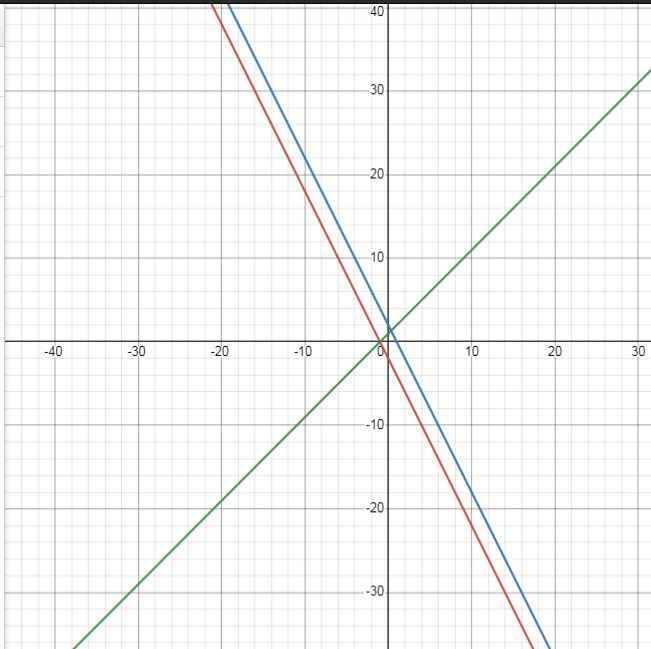Hãy nhập câu hỏi của bạn vào đây, nếu là tài khoản VIP, bạn sẽ được ưu tiên trả lời.

(d1) đi qua A => thay x=2, y=0 vào hàm số ta có: 0=4m+4n=> 4(m+n)=0 <=> m+n=0
d1//d2=> a=a' và b khác b' hay 2m=4 và 4n khác 3 <=> m=2 => n=-2(t/m đk)
=> m=2 và n=-2

1) Vì (d) song song với (d2) nên 2m=4
hay m=2
hay (d): y=4x+4n
Vì (d) đi qua A(2;0) nên Thay x=2 và y=0 vào (d), ta được:
\(4\cdot2+4\cdot n=0\)
\(\Leftrightarrow4\cdot n=-8\)
hay n=-2
Vậy: m=2; n=-2
- Ta có : đường thẳng d song song với đường thẳng d2 .
\(\Rightarrow\left\{{}\begin{matrix}a=a^,\\b\ne b^,\end{matrix}\right.\)
\(\Rightarrow\left\{{}\begin{matrix}2m=4\\4n\ne3\end{matrix}\right.\)
\(\Rightarrow\left\{{}\begin{matrix}m=2\\n\ne\dfrac{3}{4}\end{matrix}\right.\)
- Thay m vào đường thẳng ta được : \(y=4x+4n\)
Lại có : d đi qua điểm A .
- Thay tọa độ của A vào đường thẳng ta được :
\(0=4.2+4n\)
\(\Leftrightarrow n=-2\left(TM\right)\)
Vậy ...

1. Vì \((d_1)\parallel (d_2)\) \(\Rightarrow\left\{{}\begin{matrix}m-1=-2\\m-2\ne3\end{matrix}\right.\Rightarrow m=-1\)
2.a) (P) đi qua \(M\left(1;2\right)\Rightarrow2=a\Rightarrow y=2x^2\)
bạn tự vẽ nha
b) Gọi pt đường thẳng AB là \(y=ax+b\)
\(\Rightarrow\left\{{}\begin{matrix}3=2a+b\\0=-a+b\end{matrix}\right.\Rightarrow\left\{{}\begin{matrix}3=2a+b\left(1\right)\\0=-2a+2b\left(2\right)\end{matrix}\right.\)
Lấy \(\left(1\right)+\left(2\right)\Rightarrow3b=3\Rightarrow b=1\Rightarrow a=1\Rightarrow y=x+1\)
pt hoành độ giao điểm \(2x^2-x-1=0\Rightarrow\left(x-1\right)\left(2x+1\right)=0\Rightarrow\left[{}\begin{matrix}x=1\\x=-\dfrac{1}{2}\end{matrix}\right.\)
\(\Rightarrow\left[{}\begin{matrix}y=2\\y=\dfrac{1}{2}\end{matrix}\right.\Rightarrow\) tọa độ của 2 giao điểm là \(\left(1,2\right)\) và\(\left(-\dfrac{1}{2},\dfrac{1}{2}\right)\)

(d1) đi qua A => thay x = 2 , y = 0 vào hàm số ta có : 0 = 4m + 4n => 4(m+n) = 0 <=> m - n = 0
d1//d2 => a=a' và b khác b' hay 2m = 4 và 4n khác 3 <=> m = 2 => n = -2(t/m đk)
=> m = 2 và n = -2

Gọi pt d2 có dạng \(y=ax+b\)
Do d2 qua A và B nên ta có:
\(\left\{{}\begin{matrix}a+b=2\\-3a+b=-2\end{matrix}\right.\) \(\Rightarrow\left\{{}\begin{matrix}a=1\\b=1\end{matrix}\right.\) \(\Rightarrow d_2:y=x+1\)
Do \(d_1\) song song \(d_2\) nên chúng có cùng hệ số góc
\(\Rightarrow k=1\)

\(a,d//d_1\Leftrightarrow\left\{{}\begin{matrix}m+2=-2\\m\ne3\end{matrix}\right.\Leftrightarrow m=-4\\ b,d\perp d_2\Leftrightarrow\dfrac{1}{3}\left(m+2\right)=-1\Leftrightarrow m+2=-3\Leftrightarrow m=-5\\ c,d.qua.N\left(1;3\right)\Leftrightarrow x=1;y=3\Leftrightarrow3=m+2+m\\ \Leftrightarrow2m=1\Leftrightarrow m=\dfrac{1}{2}\)

a: Để (d)//(d1) thì \(\left\{{}\begin{matrix}m^2+2m=-1\\m+1\ne-2023\end{matrix}\right.\)
=>\(\left\{{}\begin{matrix}m^2+2m+1=0\\m\ne-2024\end{matrix}\right.\)
=>\(\left\{{}\begin{matrix}\left(m+1\right)^2=0\\m\ne-2024\end{matrix}\right.\)
=>(m+1)2=0
=>m+1=0
=>m=-1
b: Thay x=0 và y=2024 vào (d), ta được:
\(0\left(m^2+2m\right)+m+1=2024\)
=>m+1=2024
=>m=2023
c: Tọa độ giao điểm của (d2) và (d3) là:
\(\left\{{}\begin{matrix}x-2=-4x+3\\y=x-2\end{matrix}\right.\)
=>\(\left\{{}\begin{matrix}5x=5\\y=x-2\end{matrix}\right.\Leftrightarrow\left\{{}\begin{matrix}x=1\\y=1-2=-1\end{matrix}\right.\)
Thay x=1 và y=-1 vào (d), ta được:
\(1\left(m^2+2m\right)+m+1=-1\)
=>\(m^2+3m+2=0\)
=>(m+2)(m+1)=0
=>\(\left[{}\begin{matrix}m+2=0\\m+1=0\end{matrix}\right.\Leftrightarrow\left[{}\begin{matrix}m=-2\\m=-1\end{matrix}\right.\)

a) \(\left(d_1\right):y=-2x-2\)
\(\left(d_2\right):y=ax+b\)
\(\left(d_2\right)//d_1\Leftrightarrow\left\{{}\begin{matrix}a=-2\\b\ne-2\end{matrix}\right.\)
\(\Leftrightarrow\left(d_2\right):y=-2x+b\)
\(M\left(2;-2\right)\in\left(d_2\right)\Leftrightarrow-2.2+b=-2\)
\(\Leftrightarrow b=2\) \(\left(thỏa.đk.b\ne-2\right)\)
Vậy \(\left(d_2\right):y=-2x+2\)
b) \(\left\{{}\begin{matrix}\left(d_1\right):y=-2x-2\\\left(d_2\right):y=-2x+2\end{matrix}\right.\)

c) \(\left(d_3\right):y=x+m\)
\(\left(d_1\right)\cap\left(d_3\right)=A\left(x;0\right)\Leftrightarrow\left\{{}\begin{matrix}y=x+m\\y=-2x-2\end{matrix}\right.\)
\(\Leftrightarrow\left\{{}\begin{matrix}0=x+m\\0=-2x-2\end{matrix}\right.\)
\(\Leftrightarrow\left\{{}\begin{matrix}m=1\\x=-1\end{matrix}\right.\)
\(\Rightarrow\left(d_3\right):y=x+1\)

Vì (d1)//(d2) nên 4m=4 ⇔ m=1
Khi đó ta có pt (d1): y=4x+n
Vì (d2) đi qua điểm A(2;0) nên ta có:
0=4\(\times\)2+n ⇔ 8+n=0 ⇔ n=\(_{^{ }-8}\)
Vậy m=1 và n= -8